|
THE FAIRFORD BRANCH LINE |
|
|
|
YARNTON JUNCTION |
|
The Fairford Branch diverged from the Oxford to Worcester line (the former Oxford, Worcester & Wolverhampton Railway) at Yarnton Junction (SP474114), which was approximately 3½
miles north of Oxford station. A basic two platform station was provided, with a rather spartan wooden station building on the up platform and tall signal box at the Oxford end of the down platform. Although the buildings
were demolished many years ago, it is still possible to view the location, as a public footpath crosses the site. It is easiest to approach on the path from near Yarnton church. You are guided to the site by that
characteristic of former Great Western station sites - a line of Scots Pine trees. |
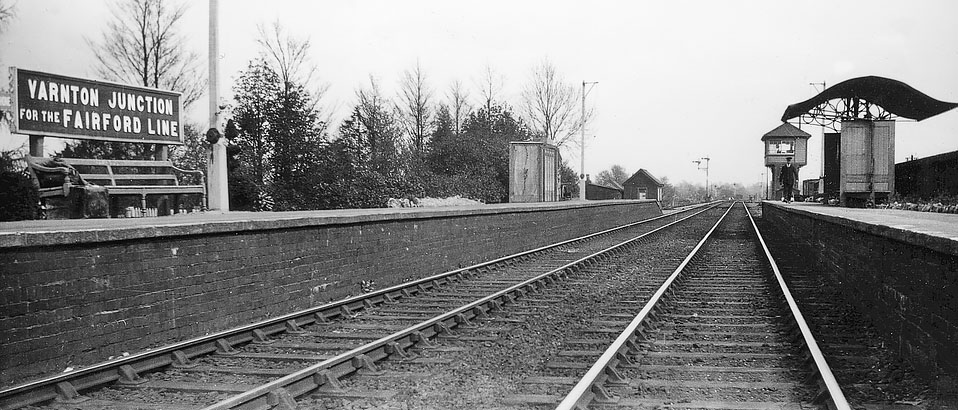 |
|
The basic facilities provided at Yarnton Junction station are evident in this early view looking towards Oxford. The tall signal box dominates the background, in front of which is a
small waiting shelter with a strikingly unusual canopy. This down platform originally had two faces, but as can be seen here was soon fenced off from the loop line. On the left, the up platform only had a cast iron
gentleman's toilet, which was joined in later years by a small wooden building, which was provided when the station house was demolished. Rather strangely, this house was situated at the north end of the up platform, hard
up against the line. A couple of huts at the far end of the platform complete the picture.
Martin Loader Collection |
|
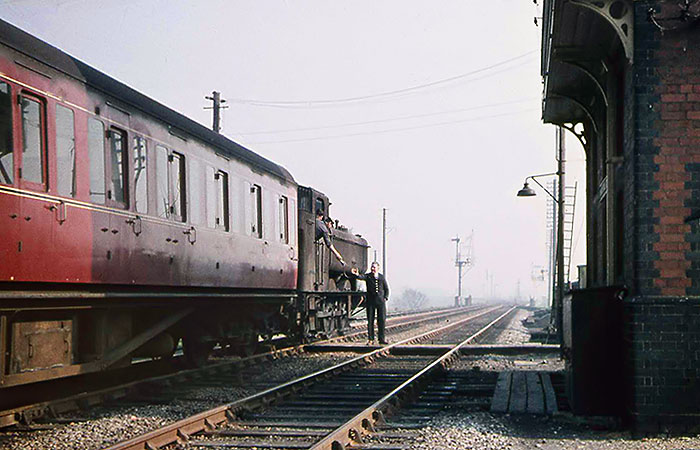
|
|
The driver of 74xx 0-6-0PT 7412 working the 12:32 Fairford to Oxford service hands over the token for the Eynsham to Yarnton Junction section to the Yarnton signalman. This March 1961
view is looking towards the 'LMS Loop' line that diverged to the left to connect with the former LMS Oxford to Bletchley line at Oxford Road Junction. This was a very little used line in later years. A light mist rolling
in off the River Cherwell water meadows slightly obscures the up main signal, which is 'off' for the branch train. However Wolvercote Junction's distant signal, just below it on the same arm is 'on', therefore the train
will have to wait just around the corner for a train on the Oxford to Banbury line.
Tony Doyle |
|
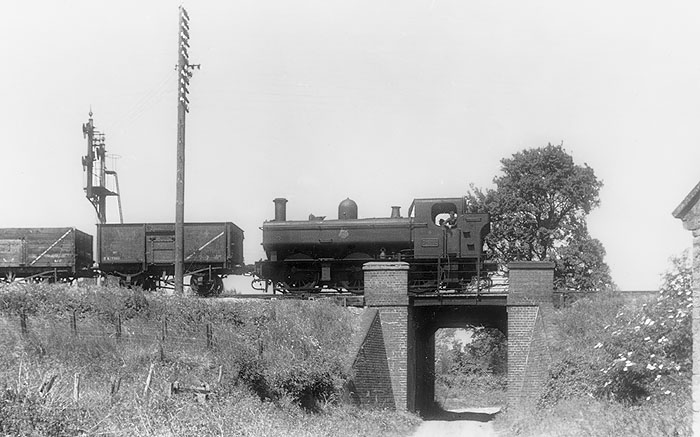
|
|
Regular branch loco 74xx 0-6-0PT 7412 is pictured again just a few yards from the previous picture and facing the other way. It is pictured crossing the underbridge between the two junctions at Yarnton
with the 11:15 Fairford to Hinksey Yard freight on a fine June day in 1957. The signal on the main post controls access to the 'LMS' loop, while the bracket nearest the camera has Yarnton Junction's up starter and
Wolvercote Junction's distant one above the other. 7412 has come through the loop line behind the signal box as is just rejoining the main line. Presumably the building just visible on the extreme right of this picture is
purely agricultural and not connected with the railway.
H. C. Casserley |
|
Yarnton Junction Signalbox was a striking building, with the 25 ft x 12 ft timber cabin noticeably wider than the very tall brick pedestal on which it stood. This in combination
with the remote location afforded some splendid views of the countryside. Originally this 1909 box housed a pioneering McKenzie & Holland electric frame with miniature levers, all powered by batteries. Later a
standard 51 lever mechanical frame was installed which lasted until the box finally closed on 28 March 1971, although it had in effect been redundant ever since the Witney Branch closed the previous autumn. It is
pictured here in around 1960.
Stanley C. Jenkins Collection |
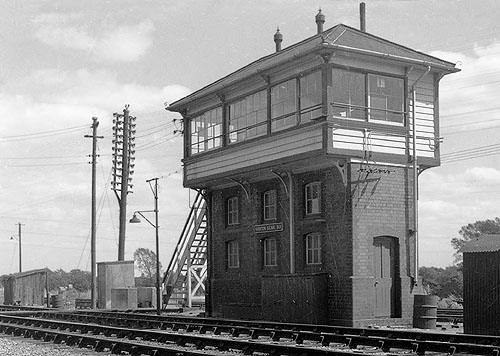
|
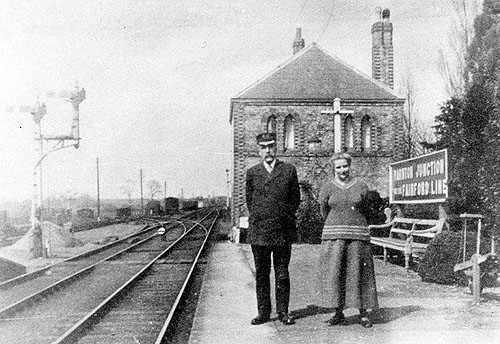 |
Originally the station master's house at Yarnton was situated at the 'country' end of the up platform, next to the actual junction and perilously close to the running lines. This Edwardian view (left) shows
the station master and his wife with the house behind. As can be seen it was quite a distinctive design with narrow early gothic style windows and elaborate brickwork. It was demolished at a relatively early date and had
certainly gone by the early 1930s. The view below shows the same location in the 1950s.
Martin Loader Collection |
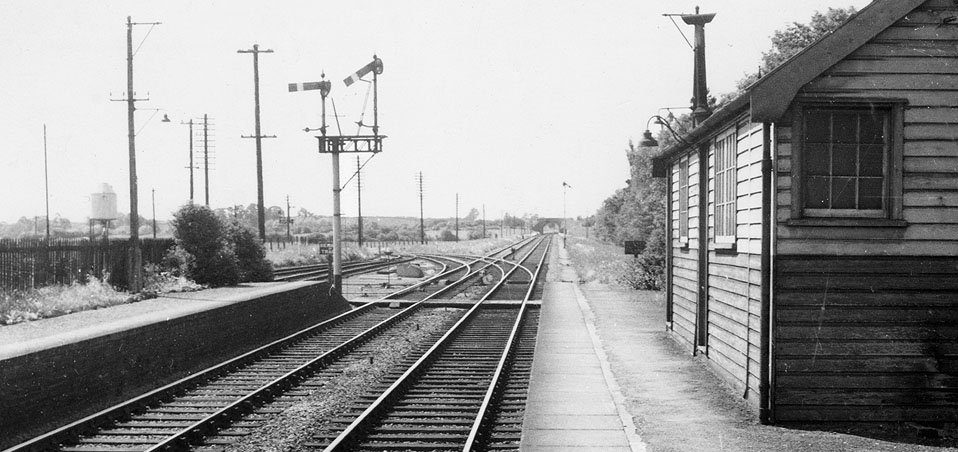 |
|
Another view of the rather basic wooden station building at Yarnton, apparently in a vandalised state, with numerous broken windows. The village of Yarnton was some distance away, but no more distant than some of the other
stations on the line. However, the lack of road access made it seem much more remote.
Stanley C. Jenkins
|
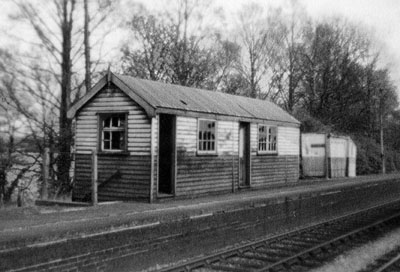 |
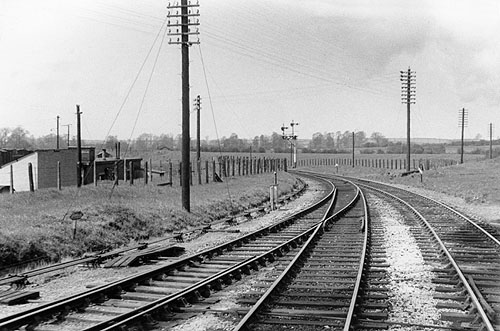
|
This view, taken from the rear of an up train approaching Yarnton from Cassington, shows the Fairford branch curving away to the south west, with just a glimpse of some of the buildings associated with the adjacent wartime marshalling yard. Note the way that the line of telegraph poles
for the Oxford to Worcester line at this point are some distance from the main line, which is off to the right of this picture.
Norman Simmons
|
|
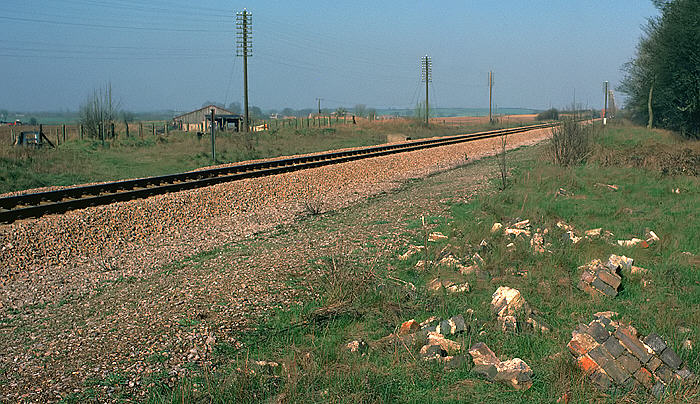
|
|
This 4 April 1980 view shows the site of Yarnton Junction, looking west. The Fairford Branch diverged to the left near the second telegraph pole. Rubble from the former up platform
litters the foreground, while the farm building in the background is on the site of the wartime marshalling yard. In 2005 the site is a little more overgrown, the telegraph poles long gone and a large earth bank hides the
former yard area, which is now home to a waste recycling company. The public footpath crosses the line here, the stile visible on the left of the picture is still in use. The post that once supported the 'Beware of Trains'
notice by the footpath crossing is just in front of the farm building.
Martin Loader |
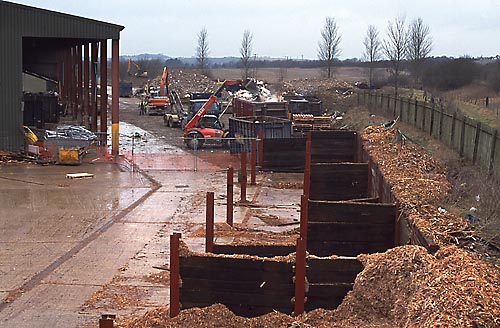 |
On 1 March 2003 the site of the former wartime marshalling yard had become a large recycling plant. Taking advantage of the earth bank at the end of the site to gain some extra
height, this view is taken from a position on the far left of the above picture. The course of the Fairford Branch can be seen behind the fence on the right.
Martin Loader |
|
This July 1971 picture from a similar viewpoint shows the recently severed Fairford Branch tracks curving away to the left. Very soon after this picture was taken, the main Oxford
to Worcester line was singled from Wolvercote Junction to Ascott-under-Wychwood, creating a ridiculously long 14 mile section which is the bane of the present day train operating companies and can create inordinate
delays if just one train is late running.
Colour Rail |
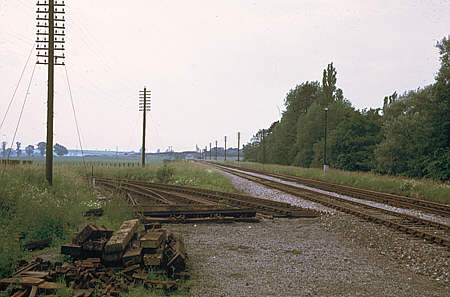
|
|
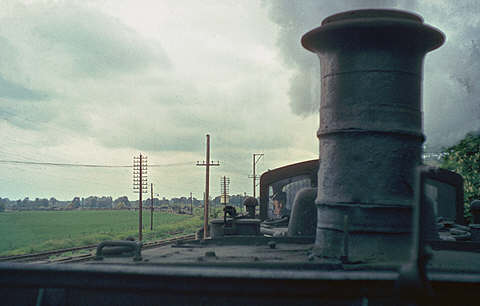
|
A slightly unusual perspective on an unusual subject at Yarnton Junction. Instantly recognizable around Oxford during the last days of steam was 74xx 0-6-0PT 7412 by virtue of its
unusual improvised chimney repair using part of an oil drum. This view from the cab of sister locomotive No. 7404 is of the 14:25 Fairford to Oxford service on 11 June 1962. The Fairford Branch curves away to the left
behind the standard GWR water tower, which can just be seen above 7412's tank filler.
Paul Strong |
|
Yarnton station set the scene for other stations along the branch, being set in a remote location well away from the village it purported to serve. It did not even have road
access, being primarily an interchange station, not only for the Fairford Branch, but also for trains using the Yarnton Loop which connected with the LMS Oxford to Bletchley line. The Yarnton Loop was closed on 8
November 1965, but the signal box at Yarnton remained open until the closure of the Fairford Branch, although in later years it was left switched out, only coming into use for the passage of the Witney goods. It was
finally taken out of use on 28 March 1971. |
|
During the Second World War a large marshalling yard was constructed on the south side of the Fairford Branch at the point where it curved away from the Worcester main line. Initially
used for inter-regional freight between the LMS & GWR, the sidings were later used for ironstone traffic. This remote location could not warrant provision of a shunting locomotive, so it was possible in latter years to
see BR Class 9F 2-10-0s shunting their own trains here. The yard finally closed in July 1966. The turntable is pictured (above) during the 1960s, with the weed choked sidings host to several rakes of 16 ton mineral wagons. A
close up of the makers sign (right) shows that it was built by Ransomes & Rapier Ltd of Ipswich.
R. H. G. Simpson |
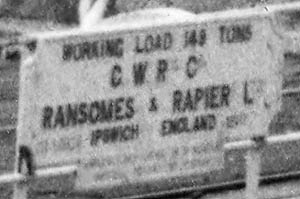
|
|
In this view (above left) looking towards Cassington, a farm building stands on the point where the sidings fanned out, while the turntable pit is prominent in the foreground.
The Fairford Branch was behind the bank on the right of the picture. Everything in this 3 October 1993 scene has now disappeared. A detail of one of the track exit and locking plates is pictured (above right) on 29 June
1986.
Martin Loader
|
|
On 4 April 1980, the battered remains of a former GWR standard corrugated iron hut was lying at the base of the bank between the Fairford Branch (on the left), and the site of the wartime marshalling
yard. The dusty track on the right of this picture roughly follows the course of the lines into the yard, at that time being used for agricultural purposes.
Martin Loader |
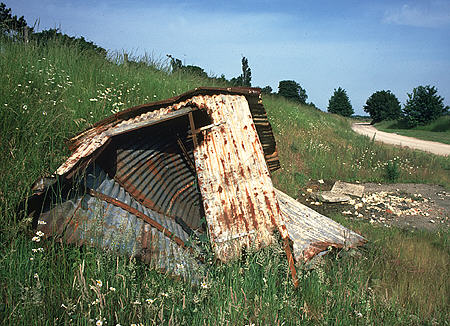
|
|
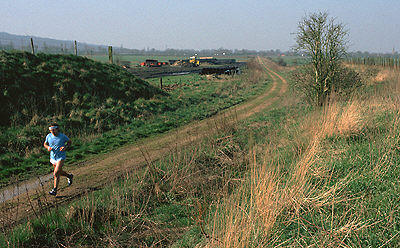
|
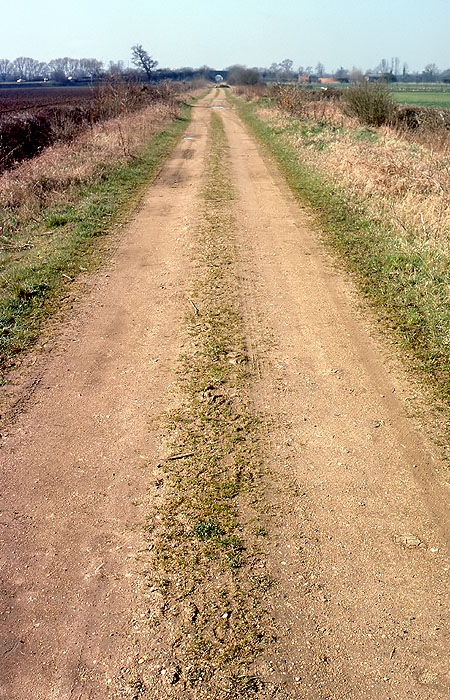
|
|
A couple of views along the old trackbed near the site of Yarnton Junction from 4 April 1980. The first view (above) shows the point where the trackbed curves to the south-west and
proceeds in a dead straight line towards the site of Cassington Halt. The jogger is passing the point (SP472114) where the footpath from Yarnton crosses the trackbed and heads off towards the village of Cassington. The
footpath is still open but this view is no longer possible. Further along towards Cassington is this view (right). At this time the trackbed was just used by farm vehicles. It was soon to be converted into a
properly surfaced road for the use of gravel lorries and vehicles traveling to the recycling plant built on the site of the former marshalling yard. Even without a tarmac surface, the ballast of the old line with an
appropriate top dressing made an excellent road, as being slightly above the level of the surrounding fields it was immune from the danger of flooding, which is a reasonably common occurrence in this area during the
winter. This picture is taken from approximately half way between Yarnton and Cassington stations (SP465109). The A40 roadbridge is visible in the distance, with traffic on the A40 just visible on the left. The brick
construction to the right of the track in the distance is the Cassington sewage works!
Martin Loader |
|